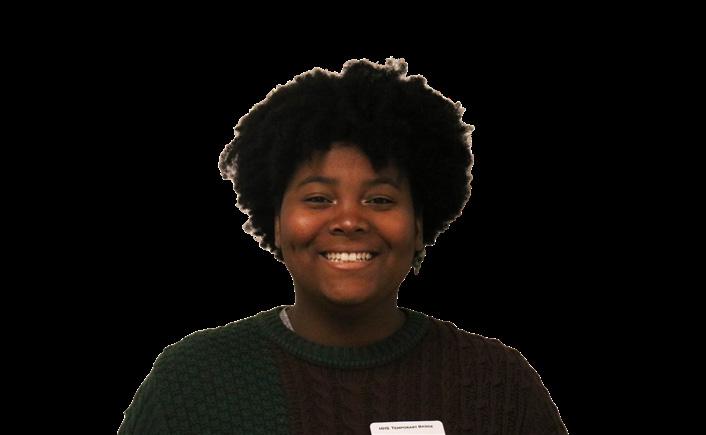
9 minute read
Advisory to be adjusted next school year
Story by Krista Fleming
Due to new protocol from the district, the daily 35-minute advisory time after second period will be shortened to 17 minutes, with time added to every other class to fill the 18-minute gap.
Advertisement
“Our goal is to only have advisory [lessons] when needed,” assistant principal Marybeth Coen said. “There won’t be a required lesson every day because we want it all to feel authentic.” with learning gaps from COVID-19, we can’t afford to waste time.”
New Bell Schedule:
First period: 8:20–9:50
Second period: 9:56–11:43
Third period: 11:49–1:59
Fourth period: 2:05–3:35
The new schedule will keep passing periods at six minutes. First and fourth period will both be 90 minutes, second period and advisory will be a collective 107 minutes and third period will be 120 minutes, including lunch time. The added minutes will be for the required topics that don’t fit under a core class. Principal Amy Boughton said she does not plan on changing the schedule further, but cannot guarantee it will stay the same.
“Sometimes, things happen,” Boughton said. “We’re still waiting for the legislature to be done, and they could push a bill through that changes requirements. If that happens, we’d make the appropriate changes, but we’re not planning on that happening.”
Why is the schedule changing?
Though the district required a specific time to be allotted to advisory weekly, schools across LISD operated on different schedules. Now, all high schools will run on the same schedule within ten minutes of each other. This standardization of the schedule is to avoid the career center having unnecessary conflicts.
“[The career centers] didn’t know when to start their classes, and students would arrive late all the time,” Boughton said. “It was a district-wide issue that needed to be fixed.”
The number of required instructional minutes per class per day also contributed to this change. Currently, each class had the state-mandated 90 minutes, but first and fourth period had fewer minutes than previous years. Boughton said she wishes there had been more instructional minutes.
“I don’t think [advisory] was being utilized properly every day, so we were losing minutes,” Boughton said. “Especially
Another thing that contributed to the new bell schedule is the state-mandated topics to cover each year, which are in constant flux. Currently, there are 14 which get stretched into multiple lessons. Many of those requirements are currently being met by sites like EverFi and Choices360, but it is not set in stone that those programs will be used in the future, nor that only 14 topics will be required next school year.
“The biggest difficulty is that every year, what’s required by the state has changed,” Coen said. “So as the changes come, we have to adapt. That’s what keeps us from having consistency [each year].”
How will advisory change?
As of now, the plan is to have advisory lessons less often and only when necessary — what is currently estimated by administration to be once a week. A part of this is due to testing at the end of each semester.
“The goal is to get to December, April and May with as few lessons to go as possible,” connects liaison and creator of some advisory lessons Kari Perkins said. “Between STAAR testing, AP tests and final exams, students are booked. To put any required lessons during those times is unfair to the students.”
The lessons will change as well; many lessons that have been recycled throughout the past few years will have to be looked at and adjusted to fit the 17 minutes allotted for them.
“I know [students] get frustrated by those videos,” Boughton said. “We do, too. I just wish they updated them more. Sometimes, it’s the same exact video for a couple years in a row, and that’s just not engaging.”
On average, do you complete your advisory lessons?
In a poll surveying student and faculty response to advisory done by the Hawk Eye, 62.4% of students said they did not do their advisory lesson and 39.6% percent said their teachers did not make them do it. In the same poll, 65.3% of students said they did not think advisory affected them at all. Perkins said she
Q&A: How do you feel about advisory being restricted?
“I hope they don’t take away advisory next year. It’s beneficial to students because we get to study, go to tutorials or just get work done. As a person that rides the bus, it’s hard to get transportation before or after school, so advisory helps out with that.” Samar
Pirbhai, freshman

“Advisory should be restricted because it has not provided anyone with anything useful. It would be more useful for club times or tutoring, so we can learn for our necessary classes instead of the dumb advisory lessons we have now.”
Abigail Wueger, sophomore
Design by Krista Fleming
hopes the new schedule changes that.
“How a teacher responds to advisory is how a student responds,” Perkins said. “If a teacher thinks it is important and has the discussions like requested, then the class will get involved. Then they all get something out of it — the [teachers] and the students. If a teacher doesn’t find it important, there’s no reason for us to expect a student to.”
What will happen to clubs?
Boughton plans to have an alternate schedule weekly for club days and pep rallies, as neither could fit into 17 minutes. This plan is not set in stone, but the principal’s advisory committee is set to discuss it at an upcoming meeting.
“I don’t want to lose all the opportunities to get involved,” Boughton said. “We have a lot of good club participation, and I’m going to figure out how to keep that.”
Another idea for club time during the day frequently discussed amongst students and faculty opts to bring back block lunch. There, some students would go to clubs or tutoring, and others would go to lunch for the first 30 minutes, before they switched to conclude the hour-long period. Block lunch was removed in 2020 due to COVID-19, and never returned.
“They should bring back block lunch,” senior Zi Thompson said. “Yes, advisory is time to get our work done, but we can’t go anywhere or have enough time to get proper work done in clubs. Block lunch was a time where you could do all the things you needed to do, and it’s definitely worth bringing back — despite it being chaotic.”
What are the challenges with this schedule?
One of the most discussed challenges with advisory is the overall negative view from some students regarding the lessons. In a poll done by the Hawk Eye, 44.6% of students said they did not find advisory necessary. Boughton, Coen and Perkins plan to get student input within the coming years with the goal of making the lessons more engaging.
“I do not like wasting people’s time,” Boughton said. “Some of the lessons did that, and I want to alleviate that as much as possible.”
With 17 minutes added for every advisory lesson, some teachers, such as English teacher Hannah Wheeler, worry that the loss of 18 minutes to cover the same requirements will cut into second period.

“There’s a lot of things we
“I really like the time that [advisory] offers, but the lessons themselves aren’t that beneficial. Without that time to study or get work done, it may be a downgrade, but the extra time in class would help me understand some of the material a little bit more.”
Olivia Evans, junior
Design by Krista Fleming
need to get done that are state mandated, and I don’t want that to take away from class time,” Wheeler said. “If advisory were to go away, I don’t know where we’d find the time to get those lessons done.”
Another issue comes from the changing bell schedule with the implementation of club and pep rally days. One of the reasons the school chose to have advisory every day was due to teacher complaints about the confusion of multiple schedules, but a consistent schedule would not be in place if club time or pep rallies were to be during the school day.
“We’re trying to take what’s required, make it effective and make as many people happy as possible,” Boughton said. “Educators are inherently very scheduled, and different bell schedules can frustrate that. Having that one consistent thing — it’s better for everyone.”
Are you for or against advisory being restricted?
During a poll done by the Hawk Eye asking those against the restriction of advisory why they felt that way, the majority said it was due to needing a break or time to get some homework done during the day. The general consensus of the 102 students polled is to limit advisory lessons while keeping the time for WebEx tutoring, asking teachers questions or getting homework done. Boughton said she agreed with those concerns, and shared similar worries about the loss of time.
“It’s good for [students] to have a minute to breathe each day,” Boughton said. “But with AP classes, fine arts and sports, when are they supposed to find time? Sitting down at 10 p.m. to finally have a breather is just not enough.”
Others think that the allotted time for advisory, if kept, should be modified in a different way, with 50.5% of students and faculty against the restrictions — many of them claiming the time would have been better as tutoring time.
“[Advisory] definitely needs to be modified,” English teacher Donna Friend said. “Kids aren’t using it for study hall. It’s downtime, and sometimes we need that, but it would be more beneficial to use that as tutoring. If we’re taking out time in our schedule for advisory, we should use it to the best of our ability.”
Boughton plans to devote specific staff training about the allotted advisory time in August, and said she does so in hopes of stopping teachers from teaching through that time.
“I want to make sure teachers are valuing that time and honoring that,” Boughton said. “[Students] need a minute to get caught up, or at least to take a breath. I’m going to make sure they have that time — even if it’s just 17 minutes.”
“They should keep [advisory] because it’s the only time we have to not do anything. Without an actual assignment, you can get caught up. If you can’t do anything before or after school, then you at least have that slot of time to do something.”
Zi Thompson, senior

Story by Emma Short Making
“Ugh, that’s not fair!”
It’s a sentiment I’ve been sharing from the time I first learned to speak, and one I still find myself mumbling under my breath.
As you can probably guess, I have never been afraid to voice my opinion. From the time I was 2 years old and my new baby brother started attracting the attention of every adult within a 50-mile radius, I just knew I could identify when things were “fair” or not.
I have been lucky enough to grow up in an extremely political and influential time where social media and opinions on controversial subjects infiltrate every aspect of daily life. In my high school years alone, I have witnessed the growth of the Black Lives Matter movement, the controversy behind COVID-19 and its vaccines, the overturning of Roe v. Wade, the #MeToo movement, countless school shootings and far too many other important social and political events where equity is a pivotal issue to count.
I also, both luckily and unluckily, am part of the first generation with the opportunity to use the internet as a voice for causes we believe in and to sound the alarm for situations that are unjust. During my sophomore year, after exploring a variety of classes to pursue in high school, I was given the greatest third medium through which I can voice important information on unjust situations: my school’s newspaper program.
Over three years, I have worked my way up from a rookie reporter to the Editor-in-Chief of “The Hawk Eye,” and I have thrived during every minute of it. Even as a reporter, I was obsessed with the idea of being the one educating our audience and using my platform to advocate for those of marginalized status. I have always poured the majority of my energy and passion into investing in people, whether that be checking up on the mental health of those close to me or using my voice to advocate against injustice. Through my work on the newspaper staff, I’ve been able to bring attention to those issues.
It has been the morning ritual of my family since I was in elementary school to turn on the news while eating breakfast before school. I witnessed countless significant events in my fascination with watching the news, inspiring me to write stories on controversial topics such as the gender pay gap, social media’s effects on the mental health of teens, the double standards between fangirls and sports fanatics, Gen Z teens handling grief, the controversy behind COVID-19 vaccines and the importance of people using their vote to voice important opinions.
I found my place writing for the newspaper, not just by writing stories,
column







